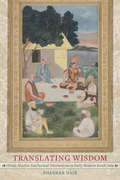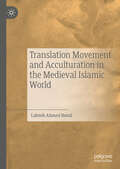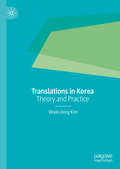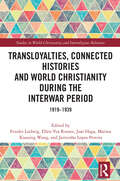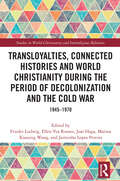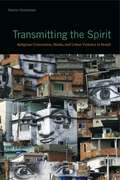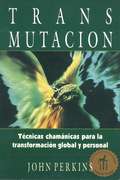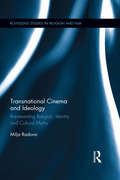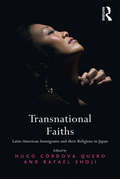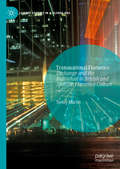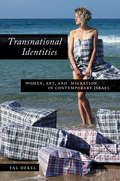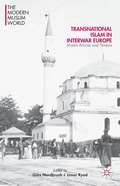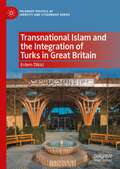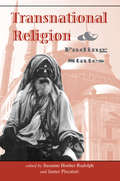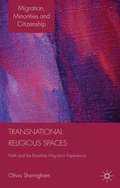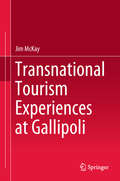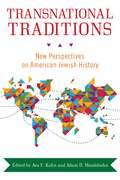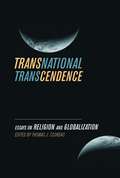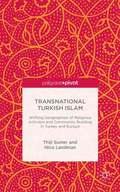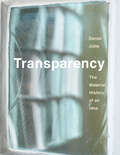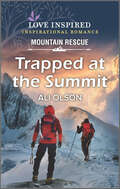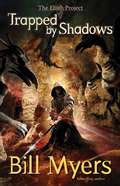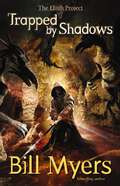- Table View
- List View
Translating Wisdom: Hindu-Muslim Intellectual Interactions in Early Modern South Asia
by Shankar NairA free open access ebook is available upon publication. Learn more at www.luminosoa.org. During the height of Muslim power in Mughal South Asia, Hindu and Muslim scholars worked collaboratively to translate a large body of Hindu Sanskrit texts into the Persian language. Translating Wisdom reconstructs the intellectual processes and exchanges that underlay these translations. Using as a case study the 1597 Persian rendition of the Yoga-Vasistha—an influential Sanskrit philosophical tale whose popularity stretched across the subcontinent—Shankar Nair illustrates how these early modern Muslim and Hindu scholars drew upon their respective religious, philosophical, and literary traditions to forge a common vocabulary through which to understand one another. These scholars thus achieved, Nair argues, a nuanced cultural exchange and interreligious and cross-philosophical dialogue significant not only to South Asia’s past but also its present.
Translation Movement and Acculturation in the Medieval Islamic World
by Labeeb Ahmed BsoulThis book investigates the transmission of knowledge in the Arab and Islamic world, with particular attention to the translation of material from Greek, Persian, and Sanskrit into Arabic, and then from Arabic into Latin in medieval Western Europe. While most modern scholarly works have addressed contributions of Muslim scholars to the modern development of translation, Labeeb Ahmed Bsoul bases his study on Arabic classical literature and its impact upon modern translation. He focuses on the contributions made by prominent classical Christian and Muslim scholars, showcasing how their works and contributions to the field of knowledge are still relevant today.
Translations in Korea: Theory and Practice
by Wook-Dong KimThis book explores practical and theoretical approaches to translation in Korea from the 16th century onwards, examining a variety of translations done in Korea from a diachronic perspective. Offering a discussion of the methodology for translating the Xiaoxue (Lesser or Elementary Learning), a primary textbook for Confucianism in China and other East Asian countries, the book considers the problems involving Korean Bible translation in general and the Term Question in particular. It examines James Scarth Gale, an early Canadian Protestant missionary to Korea, as one of the language’s remarkable translators. The book additionally compares three English versions of the Korean Declaration of Independence of 1919, arguing that the significant differences between them are due both to the translators’ political vision for an independent Korea as well as to their careers and Weltanschauungen. The book concludes with a detailed analysis of Deborah Smith’s English translation of ‘The Vegetarian’ by Han Kang, which won the 2016 Man Booker International Prize for Fiction.
Transloyalties, Connected Histories and World Christianity during the Interwar Period: 1919-1939 (Studies in World Christianity and Interreligious Relations)
by Ellen Vea Rosnes Joar Haga Frieder Ludwig Jairzinho Lopes Pereira Marina Xiaojing WangThis book introduces the approach of “transloyalties” to study “connected histories” in World Christianity. The term “transloyalties” is used to analyze the multifaceted processes in various contact zones through which cultural and religious identities were transformed in the tension between different loyalties. The volume tests this approach in various case studies, most of them focusing on Lutheran churches and “World Lutheranism” between 1919 and 1939, a time of rapidly changing political circumstances.Traditionally, the United States, Germany, and Scandinavia had been identified as the three centers of Lutheranism. However, while the structures in these centers were well established and “World Lutheranism” was something “out there,” with limited impact back home, negotiation processes on “Lutheran identity” were crucial in contexts where new Lutheran churches emerged. Asian and African church leaders operated in a new context of loyalties: They pushed for cooperation, and they often interacted with mission organizations from all three centers, and also with other religions, traditional cultures, and political movements. Therefore, it is significant what happened, for instance, in the Lutheran Church of China or at Umphumulo in South Africa.Including theoretical reflections and case studies, this volume is valuable reading for scholars of the history of World Christianity.
Transloyalties, Connected Histories and World Christianity during the Period of Decolonization and the Cold War: 1945-1970 (Studies in World Christianity and Interreligious Relations)
by Ellen Vea Rosnes Joar Haga Frieder Ludwig Jairzinho Lopes Pereira Marina Xiaojing WangFocusing on the history of World Christianity, this book relates the concept of “transloyalties” to developments during the “Period of Decolonization and the Cold War.” This was a time when the terms “loyal” and “loyalty” became more frequently used, not only in the United States, where a “loyalty program” was introduced but also in Africa, Asia, and Europe. Churches and ecumenical organizations had to navigate in this context of new loyalty demands. They had to clarify whether changes in church/ state relations and corresponding changes in their organizational structures were necessary, or whether they affected core identities. Was the restriction or exclusion of Western missionaries a threat to the universal character of the church or a transition to self-governing churches? How did African and Asian churches relate to Western mission societies in the new context? Was the strive for justice a basis for cooperation with socialist governments, or were the concepts fundamentally different? How were denominations organized at a national level? Which forms of church government were chosen? Which denominations could become members of Christian Councils that represented joint interests toward the states? These are some of the questions that underlie the importance of this volume to the study of the history of World Christianity.
Transmitting the Spirit: Religious Conversion, Media, and Urban Violence in Brazil
by Martijn OosterbaanPentecostalism is one of the most rapidly expanding religious-cultural forms in the world. Its rise in popularity is often attributed to its successfully incorporating native cosmologies in new religious frameworks. This volume probes for more complex explanations to this phenomenon in the favelas of Brazil, once one of the most Catholic nations in the world.Based on a decade of ethnographic fieldwork in Rio de Janeiro and drawing from religious studies, anthropology of religion, and media theory, Transmitting the Spirit argues that the Pentecostal movement’s growth is due directly to its ability to connect politics, entertainment, and religion. Examining religious and secular media—music and magazines, political ads and telenovelas—Martijn Oosterbaan shows how Pentecostal leaders progressively appropriate and recategorize cultural forms according to the religion’s cosmologies. His analysis of the interrelationship among evangélicos distributing doctrine, devotees’ reception and interpretation of nonreligious messaging, perceptions of the self and others by favela dwellers, and the slums of urban Brazil as an entity reveals Pentecostalism’s remarkable capacity to engage with the media influences that shape daily life in economically vulnerable urban areas.An eye-opening look at Pentecostalism, media, society, and culture in the turbulent favelas of Brazil, this book sheds new light on both the evolving role of religion in Latin America and the proliferation of religious ideas and practices in the postmodern world.
Transmutación: Técnicas chamánicas para la transformación global y personal
by John PerkinsMUCHAS CULTURAS INDÍGENAS practican la transmutación. Los cazadores nativos norteamericanos adoptan el espíritu de su presa para tener éxito en la cacería. Los médicos asiáticos "ingieren" una enfermedad para curar a la persona que la padece. Los guerreros del Amazonas se convierten en jaguares para recorrer silenciosamente la selva. Los transmutantes saben que todo ser vivo es energía, y que concentrándonos en nuestra intención podemos cambiar nuestros patrones energéticos, dando lugar a una nueva forma. La transmutación puede suceder en tres niveles: el celular (la tansformación de un ser humano en una planta o animal, o la pérdida de peso), el personal (la conversión en un nuevo ser, o el abandono de una adicción) y el institucional (la creación de una nueva identidad cultural o commercial).Desde 1968, John Perkins ha sido entrenado por maestros chamanes de África, Asia, Oriente Medio y América para que muestre al mundo industrial las poderosas técnicas relacionadas con la transmutación . Su innovador libro nos lleva a desiertos y selvas, a montañas y mares, a centros de investigación médica y a juntas directivas corporativas, para aprender, paso a paso, los métodos de esta práctica que integra técnicas antiguas y modernas para lograr una curación profunda.
Transnational Cinema and Ideology: Representing Religion, Identity and Cultural Myths (Routledge Studies in Religion and Film)
by Milja RadovicIncreasingly, as the production, distribution and audience of films cross national boundaries, film scholars have begun to think in terms of ‘transnational’ rather than national cinema. This book is positioned within the emerging field of transnational cinema, and offers a groundbreaking study of the relationship between transnational cinema and ideology. The book focuses in particular on the complex ways in which religion, identity and cultural myths interact in specific cinematic representations of ideology. Author Milja Radovic approaches the selected films as national, regional products, and then moves on to comparative analysis and discussion of their transnational aspects. This book also addresses the question of whether transnationalism reinforces the nation or not; one of the possible answers to this question may be given through the exploration of the cinema of national states and its transnational aspects. Radovic illustrates the ways in which these issues, represented and framed by films, are transmitted beyond their nation-state borders and local ideologies in which they originated – and questions whether therefore one can have an understanding of transnational cinema as a platform for political dialogue.
Transnational Faiths: Latin-American Immigrants and their Religions in Japan
by Rafael Shoji Hugo QueroJapan has witnessed the arrival of thousands of immigrants, since the 1990s, from Latin America, especially from Brazil and Peru. Along with immigrants from other parts of the world, they all express the new face of Japan - one of multiculturality and multi-ethnicity. Newcomers are having a strong impact in local faith communities and playing an unexpected role in the development of communities. This book focuses on the role that faith and religious institutions play in the migrants' process of settlement and integration. The authors also focus on the impact of immigrants' religiosity amidst religious groups formerly established in Japan. Religion is an integral aspect of the displacement and settlement process of immigrants in an increasing multi-ethnic, multicultural and pluri-religious contemporary Japan. Religious institutions and their social networks in Japan are becoming the first point of contact among immigrants. This book exposes and explores the often missed connection of the positive role of religion and faith-based communities in facilitating varied integrative ways of belonging for immigrants. The authors highlight the faith experiences of immigrants themselves by bringing their voices through case studies, interviews, and ethnographic research throughout the book to offer an important contribution to the exploration of multiculturalism in Japan.
Transnational Flamenco: Exchange and the Individual in British and Spanish Flamenco Culture (Leisure Studies in a Global Era)
by Tenley MartinThis book provides insight into how flamenco travels, the forms it assumes in new locales, and the reciprocal effects on the original scene. Utilising a postnational approach to cultural identity, Martin explores the role of non-native culture brokers in cultural transmission. This concept, referred to as ‘cosmopolitan human hubs’, builds on Kiwan and Meinhof’s ‘hubs’ theory of network migration to move cultural migration and globalisation studies forwards. Martin outlines a post-globalisation flamenco culture through analysis of ethnographic research carried out in the UK, Sevilla and Madrid. Insight into these glocal scenes characterises flamenco as a historically globalized art complex, represented in various hubs around the world. This alternative approach to music migration and globalisation studies will be of interest to students and scholars across leisure studies, musicology, sociology and anthropology.
Transnational Identities: Women, Art, and Migration in Contemporary Israel
by Tal DekelTranslated originally from Hebrew, Transnational Identities: Women, Art, and Migration in Contemporary Israel offers a critical discussion of women immigrants in Israel through an analysis of works by artists who immigrated to the country beginning in the 1990s. Though numerous aspects of the issue of women migrants have received intense academic scrutiny, no scholarly books to date have addressed the gender facets of the experiences of contemporary women immigrants in Israel. The book follows an up-to-date theoretical model, adopting critical tools from a wide range of fields and weaving them together through an in-depth qualitative study that includes the use of open interviews, critical theories, and analysis of artworks, offering a unique and compelling perspective from which to discuss this complex subject of citizenship and cultural belonging in an ethno-national state. It therefore stands to make a significant contribution to research into women's lives, citizenship studies, global migration, Jewish and national identity and women's art in contemporary Israel. The book is divided into sections, each of which aims a spotlight on women artists belonging to a distinct groups of immigrants—the former Soviet Union, Ethiopia, and the Philippines—and shows how their artwork reflects various conflicts regarding citizenship and identity-related processes, dynamics of inclusion-exclusion, and power relations that characterize their experiences. Transnational Identities promotes a more nuanced, complex understanding of diversity among women from various groups and even within a specific ethnic group, as well as considering the "common differences" between women from diversified life experiences. To lay the groundwork for an analysis of the themes that recur in their artworks, Tal Dekel briefly discusses the notions of global migration and transnationalism and then examines gender and several other identity-related categories, notably religion, race, and class. These categories underline the complex nexus of overlapping and sometimes contradictory affiliations and identities that characterize migrating subjects in an age of globalization. Transnational Identities integrates theories from various disciplines, including art history, citizenship studies and critical political theory, gender studies, cultural studies, and migration studies in an interdisciplinary manner that those teaching and studying in these fields will find relevant to their continued research.
Transnational Islam In Interwar Europe
by Götz Nordbruch Umar RyadThe book examines Muslim-European interactions in the interwar period and provides original insights into the emergence of geopolitical and intellectual East West networks that transcended national, cultural, and linguistic borders. "
Transnational Islam and the Integration of Turks in Great Britain (Palgrave Politics of Identity and Citizenship Series)
by Erdem DikiciThis book brings a transnational perspective to the study of immigrant integration in contemporary Western European societies, with a specific focus on transnational Turkish Islam and Turkish integration in Great Britain. It raises significant questions regarding national citizenship models, and offers original insights into the ways in which they can be extended and renewed to cover the cross-border reality.At the theoretical level, Dikici argues that the idea of multiculturalism can be extended to cover immigrant transnationalism without jeopardising its core principles such as equality and recognition of difference, and promises such as a shared national identity and unity in diversity. At the empirical level, the book illustrates that not all transnational Muslim organisations are the same (i.e. militant), and nor do they all hinder Muslim integration, rather they are diverse, with some deliberately contributing to the integration of Muslims into non-Muslim majority societies.The work will be of interest to scholars and students of contemporary integration and citizenship studies, multiculturalism studies, Muslim integration in Western societies, transnationalism and transnational Islam, Civil Society and Diaspora Studies.
Transnational Religion and Fading States
by Susanne Hoeber Rudolph James Piscatori<p>Focusing on the dilution of state sovereignty, this book examines how the crossing of state boundaries by religious movements leads to the formation of transnational civil society. Challenging the assertion that future conflict will be of the "clash of civilizations" variety, it looks to the micro-origins of conflicts, which the contributors argue are as likely to arise between states sharing a religion as between those divided by it and more likely to arise within rather than across state boundaries. Thus, the chapters reveal the dual potential of religious movements as sources of peace and security as well as of violent conflict. <p>Featuring an East-West, North-South approach, the volume avoids the conventional and often ethnocentric segregation of the experience of other regions from the European and American. Contributors draw examples from a variety of regions and world religions and consider self-generated movements from below (such as Protestant sectarianism in Latin America or Sufi Islam in Africa) in contrast to centralized forms of organization and patterns of diffusion from above (such as state-certified religion in China). Together the chapters illustrate how religion as bearer of the politics of meaning has filled the space left by the decline of ideology, which has created a novel transnational space for world politics.</p>
Transnational Religious Spaces
by Olivia SheringhamThis book explores the role of religion in the lives of Brazilian migrants in London and on their return 'back home'. Working with the notion of religion as lived experience, it moves beyond rigid denominational boundaries and examines how and where religion is practiced in migrants' everyday lives.
Transnational Tourism Experiences at Gallipoli
by Jim McKayThis book offers a fresh account of the Anzac myth and the bittersweet emotional experience of Gallipoli tourists. Challenging the straightforward view of the Anzac obsession as a kind of nationalistic military Halloween, it shows how transnational developments in tourism and commemoration have created the conditions for a complex, dissonant emotional experience of sadness, humility, anger, pride and empathy among Anzac tourists. Drawing on the in-depth testimonies of travellers from Australia and New Zealand, McKay shines a new and more complex light on the history and cultural politics of the Anzac myth. As well as making a ground breaking, empirically-based intervention into the culture wars, this book offers new insights into the global memory boom and transnational developments in backpacker tourism, sports tourism and “dark” or “dissonant” tourism.
Transnational Traditions: New Perspectives on American Jewish History
by Adam D. Mendelsohn Ava F. KahnDespite being the archetypal diasporic people, modern Jews have most often been studied as citizens and subjects of single nation states and empires--as American, Polish, Russian, or German Jews. This national approach is especially striking considering the renewed interest among scholars in global and transnational influences on the modern world. Editors Ava F. Kahn and Adam D. Mendelsohn offer a new approach in Transnational Traditions: New Perspectives on American Jewish History as contributors use transnational and comparative methodologies to place American Jewry into a broader context of cultural, commercial, and social exchange with Jews in Europe, the Middle East, Asia, Australia, New Zealand, and South America. In examining patterns that cross national boundaries, contributors offer new ways of understanding the development of American Jewish life. The diverse chapters, written by leading scholars, reflect on episodes of continuity and contact between Jews in America and world Jewry over the past two centuries. Individual case studies cover a range of themes including migration, international trade, finance, cultural interchange, acculturation, and memory and commemoration. Overall, this volume will expose readers to the variety and complexity of transnational experiences and encounters within American Jewish history. Accessible to students and scholars alike, Transnational Traditions will be appropriate as a classroom text for courses on modern Jewish, ethnic, immigration, world, and American history. No other single work in the field systematically focuses on this subject, nor covers the range of themes explored in this volume.
Transnational Transcendence: Essays on Religion and Globalization
by Thomas J. CsordasThis innovative collection examines the transnational movements, effects, and transformations of religion in the contemporary world, offering a fresh perspective on the interrelation between globalization and religion. Transnational Transcendence challenges some widely accepted ideas about this relationship—in particular, that globalization can be understood solely as an economic phenomenon and that its religious manifestations are secondary. The book points out that religion's role remains understudied and undertheorized as an element in debates about globalization, and it raises questions about how and why certain forms of religious practice and intersubjectivity succeed as they cross national and cultural boundaries. Framed by Thomas J. Csordas's introduction, this timely volume both urges further development of a theory of religion and globalization and constitutes an important step toward that theory.
Transnational Turkish Islam: Shifting Geographies of Religious Activism and Community Building in Turkey and Europe
by Thijl Sunier Nico LandmanTransnational Turkish Islam provides an overview of Turkish organized Islam in seven European countries. It shows how Turkish Islamic organizations have developed from typical migrant associations in the 1970s and 1980s into present-day European Islamic associations with their own cultural and religious specificities and agendas.
Transparency: The Material History of an Idea
by Daniel JutteA wide-ranging illustrated history of transparency as told through the evolution of the glass window Transparency is a mantra of our day. It is key to the Western understanding of a liberal society. We expect transparency from, for instance, political institutions, corporations, and the media. But how did it become such a powerful—and global—idea? From ancient glass to Apple&’s corporate headquarters, this book is the first to probe how Western people have experienced, conceptualized, and evaluated transparency. Daniel Jütte argues that the experience of transparency has been inextricably linked to one element of Western architecture: the glass window. Windows are meant to be unnoticed. Yet a historical perspective reveals the role that glass has played in shaping how we see and interpret the world. A seemingly &“pure&” material, glass has been endowed, throughout history, with political, social, and cultural meaning, in manifold and sometimes conflicting ways. At the same time, Jütte raises questions about the future of vitreous transparency—its costs in terms of visual privacy but also its ecological price tag in an age of accelerating climate change.
Transpersonal Perspectives on Spirituality in Social Work
by Edward R Canda Elizabeth D SmithUse these ideas in your social work practice to help the whole person--including your client's spiritual side!Transpersonal Perspectives on Spirituality in Social Work brings to light the fact that spiritual well-being is an essential part of the health of every individual. It will show you how to facilitate and encourage growth in the transpersonal dimension for your clients and help you to address the full range of human potential--from material and psychological well-being to spiritual fulfillment.Beginning with conceptual and theoretical frameworks for understanding transpersonal theory, Transpersonal Perspectives on Spirituality in Social Work goes on to deliver empirical and clinical studies that center on true-life experiences and their social work practice implications. In this well-researched book you will find: a comparative analysis of various models of spirituality and spiritual development a study of chronically ill adults that shows how people can draw upon transpersonal experiences and beliefs to increase their resiliency suggestions for alleviating death-related anxiety with a transpersonal/social constructionist approach theoretical, empirical, and practical insights into transpersonally oriented hospice work a model for transpersonal couples work that promotes compatibility and intimacy ways to differentiate between delusions, hallucinations, and real spiritual breakthroughs an examination of the different styles of spirituality of African Americans and European Americans and how they relate to the expression of violenceIn this well-referenced volume, practical techniques and suggestions combine with ways to work for justice and empowerment for marginalized and oppressed populations as well as insights about the fundamental connectedness between people and nature. Helpful diagrams, charts, and tables make the information user-friendly. Transpersonal Perspectives on Spirituality in Social Work will help you expand the horizons of your practice and provide more effective services to your clients.
Transposing Broadway
by Stuart J. HechtHecht examines the relationship between Jewish assimilation and the changing face of the American musical though the twentieth century and into the twenty-first century.
Trapped at the Summit (Mountain Rescue)
by Ali OlsonThey will need each other to survive…But they&’re running out of time Valerie Butler won&’t let anything stop her from climbing Washington's formidable Mount Rainier. But when she partners with expert mountaineer Jonah Aarons, they confront unexpectedly brutal weather conditions—and one treacherous obstacle after another. Now, with Valerie&’s secrets and Jonah&’s tragic past overshadowing their every move, can they find the strength to survive—and make their way home to each other at last?
Trapped by Shadows (The Elijah Project #3)
by Bill Myers James RiordanWhen the forces of the evil Shadow Man kidnap six-year-old Elijah, his parents and siblings, Zach, aged sixteen, and Piper, aged thirteen, face their own weaknesses when they enter the Abyss to try and save him.
Trapped by Shadows (The Elijah Project)
by Bill MyersIn book three, Trapped by Shadows, Elijah is captured, and his family must enter the Abyss to save him. The deeper they plunge into the caves, the greater the danger to them all, but they are not alone. Heaven is on their side.
